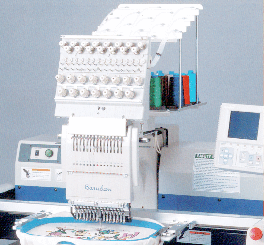Embroidery is defined as work with needle and thread upon cloth. Most embroidery commercially is made using a computer controlled machine to move the cloth around below a sewing head. The method of stitching on most embroidery machines is lockstitch, which is the type of stitch produced by most domestic sewing machines, and uses a similar needle action, and the same type of bobbin found on domestic machines. The main difference is the addition of many more sewing needles (which can be changed automatically, usually to change colours), and the movement for the embroidery frame.
Designs are produced quickly and easily on a computer, with special software, and then the design can be given to the machine on standard computer disks, by memory stick or email. Once the embroidery machine is threaded up, the frame filled with the right cloth, the button can be pressed and the whole embroidery produced automatically.
Ellis Developments have taken these well established techniques, but applied them to technical problems such as the need to strengthen glass fibre reinforced floors for automobiles in specific places where the highest strength is needed, such as the seat belt anchorages, which become highly loaded during an accident. Making the whole floor of the car very strong is another solution, but the extra weight adds to the running costs of the car for its whole life: the use of a glass washer, with all the fibres within it placed in such a way that the high loads are distributed away from the anchor hole in the most efficient way, is the most cost effective solution.
The development of this and other products made in the same way was developed during a major research project, called the MASCET project. We have worked on the development of a number of experimental components for an aircraft wing using carbon fibre in order to reduce the weight of the wing. The carbon is laid down using one or other embroidery techniques to optimise the fibre architecture and hence the structural efficiency of the component. This leads to reduced weight, and thus fuel saving. Within the structure we can incorporate sensor fibres for structural health monitoring
Our techniques for making surgical implants by embroidery are described elsewhere.
email: info@ellisdev.co.uk We are based at Far Close, Rolleston Road, Fiskerton, Southwell, Nottinghamshire, NG25 0UJ, United Kingdom

